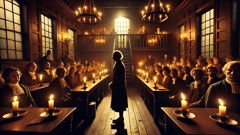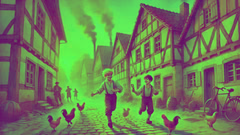Introduction
When dusk falls across the rolling fields and tangled bushland of Campbelltown, a subtle chill seems to settle—one that has nothing to do with the cool New South Wales air. The shadows lengthen, the gum trees whisper, and locals glance toward the banks of the tranquil George’s River, where a story as old as the colony itself still clings to the mist. This is the setting for the legend of Fisher’s Ghost, a tale so entwined with Campbelltown’s past that it shapes the town’s very identity. In the early 1820s, Campbelltown was a fledgling settlement at the edge of the known world, ringed by thick forests and wild, untamed land. Life was hard, fortunes were made and lost overnight, and trust was a rare commodity. It was here that Frederick Fisher, a prosperous, if unassuming, emancipated convict and landowner, vanished one fateful night. What followed was a mystery that would grip the colony, shatter friendships, and bring about an extraordinary reckoning—not through the diligence of lawmen or the cries of townsfolk, but by the intervention of something otherworldly. The ghostly figure who would come to be known as Fisher’s Ghost did more than haunt the dreams of those who wronged him; he became a symbol of justice reaching beyond the grave. Campbelltown, once just another dot on the colonial map, became a place whispered about across Australia. The tale’s details—part fact, part myth—have passed from generation to generation, echoing through the eucalyptus groves and overgrown paddocks. To walk these streets today is to step through history’s thin veil, where the land remembers, and the past never truly sleeps.
A Town on the Edge: The Disappearance of Frederick Fisher
Campbelltown in 1826 was a place where fortunes rose and fell like the winds that swept through its open fields. For many, it was a fresh start—an escape from the sins and struggles of the old world. Convicts could become landowners, and honest labor sometimes led to prosperity. Frederick Fisher had managed what many could only dream of. Arriving in Australia as a convict for forgery, he had served his time, kept to himself, and quietly built a comfortable life. His small cottage stood on a gentle rise, surrounded by neat paddocks and the lazy bends of George’s River. He was respected—perhaps envied—by some, but for most, he was simply part of the town’s patchwork.

It was in June of 1826 that Fisher vanished. At first, nobody panicked. He was a private man, and rumors of debts or family troubles were easy to believe. But as the days passed, and then weeks, unease grew. His friend and neighbor, George Worrall, insisted Fisher had returned to England, leaving Worrall as caretaker and eventually legal claimant of his property. Worrall produced a letter—supposedly from Fisher himself—granting him rights over the land. It seemed suspicious, but few dared question too loudly. Life in the colony was often built on secrets and half-truths.
Yet the whispers wouldn’t die down. Fisher’s friends, including a laborer named Joseph Locker, were troubled. Why would Fisher leave his farm, his cattle, and his hard-won respect without a word to those closest to him? Some suspected foul play, but without a body, there was little the authorities could do. Police investigations turned up nothing. The land, thick with bush and riddled with rabbit holes, offered a thousand places to disappear. Worrall continued to live on Fisher’s property, managing his affairs with a nervous energy that many noticed but few could challenge.
Campbelltown tried to return to normal, but the sense of something unresolved lingered. People grew wary of the night. Dogs howled more often. The wind seemed to carry secrets. Then, one evening in September, a local farmer named John Farley stumbled into a local inn, pale and shaken, claiming he’d seen the impossible. He told of a figure—tall, gaunt, spectral—standing silently on a rail above a bridge near Fisher’s land. The apparition pointed wordlessly to the ground before vanishing into the swirling mist. Farley’s story was met with disbelief and nervous laughter, but he swore by what he’d seen, and others couldn’t help but recall strange feelings near that same bridge. Suddenly, Fisher’s disappearance no longer seemed like a simple mystery.
The community’s anxiety deepened. Some avoided the bridge after dusk; others visited in hopes of catching a glimpse of the ghost. News of Farley’s sighting reached the authorities. The story was too compelling to ignore—especially as more townsfolk began reporting eerie sounds and fleeting visions near the riverbank. Whether out of genuine belief or simple curiosity, a group of men organized a search. Guided by Farley’s account, they scoured the ground beneath the bridge. There, where the apparition had pointed, they found the earth disturbed. Digging down, they unearthed a body, hastily buried and badly decomposed, but still recognizable by its clothing and a distinctive ring. Frederick Fisher had been found at last.
The shockwave through Campbelltown was immediate. Suspicion turned to outrage, and the focus swung to George Worrall. Confronted with the evidence, Worrall faltered. He denied nothing, instead launching into a tangled confession of debts, desperation, and a final, fatal confrontation. The details were sordid—Worrall’s envy and greed had led to murder. Fisher’s ghost, whether real or imagined, had exposed a crime that might otherwise have been lost in the wild emptiness of colonial Australia.
A Ghost’s Justice: Unraveling Truth and the Birth of a Legend
The discovery of Frederick Fisher’s body did more than solve a mystery—it ignited a legend that would outlive the original crime by centuries. News of the ghost’s intervention spread beyond Campbelltown, racing along telegraph lines and colonial tracks to Sydney and beyond. For a society obsessed with order but ruled by unpredictability, the idea that a restless spirit could right a mortal wrong was as comforting as it was chilling.

The subsequent trial drew crowds from distant districts. George Worrall, once an unremarkable neighbor, became the object of morbid fascination. His trial was swift. The evidence against him—the forged letter, the suspicious behavior, his own panicked confession—left little doubt. The testimony of John Farley, though legally inadmissible as evidence, weighed heavily in the court of public opinion. People wanted to believe that justice could transcend the bounds of life and death. In December of 1826, Worrall was found guilty and hanged, his fate sealing the story in Campbelltown’s collective memory.
In the years that followed, the legend grew. The site of Fisher’s grave became a place of pilgrimage and uneasy curiosity. Some claimed to see his ghost wandering near the riverbank, head bowed and shoulders hunched, especially in the foggy hours before dawn. Stories spread of strange lights flickering in the fields and the sound of soft footsteps following travelers on the old road. Fisher’s ghost became part of Campbelltown’s identity—a warning to wrongdoers and a reassurance to those seeking justice.
But the legend also became a lens through which locals examined their own fears and hopes. Australia was a land of new beginnings but also deep uncertainties. The bush hid both opportunity and danger; the law was often distant, and retribution uncertain. Fisher’s Ghost stood as a reminder that the land itself could bear witness—that secrets could not remain buried forever. Artists painted eerie nightscapes of the riverbank; writers and poets retold the story in ballads and newspapers. Fisher’s Ghost became a staple of colonial folklore.
By the late nineteenth century, Campbelltown had changed. The railway had arrived, farms multiplied, and new generations grew up hearing tales of the ghost on misty nights. The story took on fresh meanings as Australia moved toward federation and modernity. Was Fisher’s Ghost a true specter, or just the product of guilt and local imagination? Did John Farley see something supernatural, or had he pieced together clues that others overlooked? The legend endured because it captured something essential—a belief in justice, however it might come about, and in the power of stories to shape not just memory but identity.
Legacy in Shadow: Fisher’s Ghost in Modern Campbelltown
The story of Fisher’s Ghost didn’t fade with time—it deepened. As Campbelltown grew into a bustling suburb of Sydney, the legend remained woven into the town’s character. In 1956, over a century after Frederick Fisher’s death, the community embraced its spectral heritage by founding the annual Fisher’s Ghost Festival—a vibrant event that mixed pageantry, music, art, and a healthy dose of ghostly theatrics.

Each November, Campbelltown comes alive with parades, lantern-lit processions, and retellings of the famous tale. Schoolchildren dress as ghosts and townsfolk compete for best historical costume. Local artists paint dramatic murals of the riverbank and the fateful bridge. There are fireworks, food stalls, and performances that blend history with myth. The festival honors not just Fisher’s memory, but the enduring power of storytelling to unite a community.
Yet, for all its modern celebration, the story still holds an undercurrent of unease. Some older residents claim the festival wakes restless spirits; others insist that after the crowds leave and darkness returns, the old bridge is still a place best avoided. Amateur ghost hunters wander the riverbanks with cameras and recorders, chasing fleeting chills and whispering winds. Visitors come from across Australia, eager to glimpse the place where fact and folklore collide.
Campbelltown’s landscape has changed. Highways cut through fields where once only horses rode; houses and shops now stand where bushland grew thick and wild. But echoes of the past remain. The river still glides silently through town, its surface reflecting the moonlight and the memories that linger in every bend. The bridge—though rebuilt—still draws curious eyes, especially on misty nights when the moon is high and the world feels thin.
Fisher’s Ghost is more than a local legend; it’s a story about what it means to belong to a place shaped by hardship and hope. It reminds Campbelltown—and Australia—that justice has many faces, and that even in a land built on fresh starts, the past is never entirely left behind.
Conclusion
Today, the legend of Fisher’s Ghost endures—a story that began with a man’s mysterious disappearance and grew into an emblem of Campbelltown’s spirit. Walk the riverbank at dusk, or join the festival crowds, and you’ll sense the thin boundary between history and myth. The land still remembers; the community still honors its spectral guardian. Whether you believe John Farley truly saw a ghost or think the answers lie in guilt and intuition hardly matters. Fisher’s Ghost remains alive in art, in annual celebrations, and in the quiet hush that falls over Campbelltown on foggy nights. It’s a tale about justice found in unexpected ways—a reminder that stories can shape destinies as surely as any law or verdict. In Campbelltown, the past is never truly gone; it lingers, inviting each new generation to listen for footsteps on the bridge, to look twice at the shifting mist, and to remember that every place has its ghosts.


















